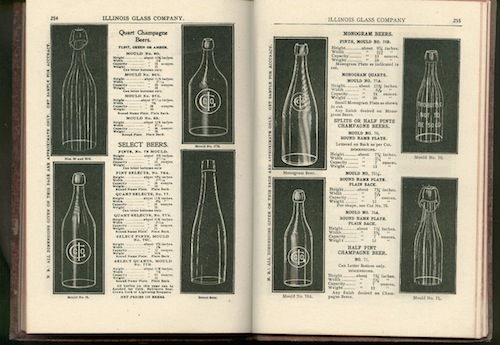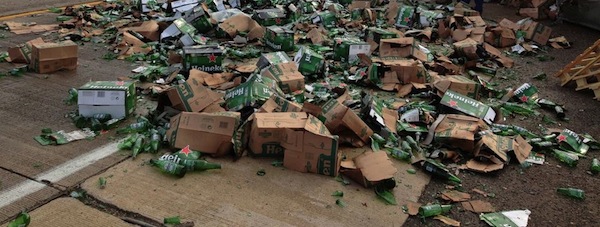The Beginner’s Guide to Craft Beer
Photo of the Wall of Canned Beer at Burro Bar Drink Features craft beerHave you been wanting to get into beer but don’t know how to talk about it? Maybe you’ve wanted to join a homebrew club or impress that cute bartender?
This guide is geared towards beginners who enjoy drinking beer but may not know how to talk about it. First, we’ll get you started on common terms to describe beer, use that knowledge to discuss general beer styles, and then talk about common off-flavors that may affect the beer you’re tasting.
So let’s hop in!
Common Terms
Photo via Historical Archeological Society
Before we learn about beer styles, we need to know how to talk about them. Below are some terms to start you on your journey.
Light-Medium-Dark: In reference to color of the beer only. Light beers can be straw-colored, yellow, gold, tan. Medium-colored beers can be amber, red, copper, orange. Dark beers can be brown, black, opaque, coffee-like.
Light-Medium-Heavy: In reference to the body and mouthfeel of the beer. Light-bodied beers tend to be clean and crisp. Heavy-bodied beers tend to cling to the mouth, feel oily, rich, or full.
Malty: Malted barley (or malt) is a main beer ingredient of beer. The level of kilning or roasting determines the color and flavor (like how roasting affects coffee beans). Lighter malts taste nutty, biscuity, like cereal; medium roasts like toffee or caramel; and dark roasts like coffee, dark chocolate, dried dark fruits.
Hoppy: Another main beer ingredient that imparts flavor and aroma. Hops can be fruity: apple, citrus, tropical fruits; or piney: resin, pine needles, wood; or floral, earthy, spicy, grassy.
Bitter: Bitterness comes from hops, but not all hoppy beers are bitter. It all depends on when you add the hops. When balanced with strong malt character, bitterness can be quite pleasant.
Fruity: Common fruity flavors and aromas are lemon, banana, grapefruit, apricot, plum, cherry.
Spicy: Not spicy like chilies – though adventurous brewers use those too – but spicy like coriander, clove, pepper, star anise.
Beer Styles
Infographic from Burke University
In the interest of creating a beginner’s guide, the styles listed below are general descriptions, and some aren’t even mentioned at all. For a more in-depth look at beer styles and history, you should read Randy Mosher’s Tasting Beer, or if you’re feeling adventurous, download the Beer Judge Certification Program’s Style Guidelines.
Pale Ales/India Pale Ales (IPA)
All pale ales and IPAs use hops prominently, but the American versions, especially those from the West Coast, are much hoppier. English and American brewers also tend to use different hop varieties, which results in distinct flavors. English ales lean towards spicy and green, while American ales lean towards citrus and pine.
Two Examples: Firestone Walker DBA (English style pale ale), Bear Republic Racer 5 (American style IPA)
Wheat
Most beers use 100% malt, but not so with these beers which use 40-60% wheat instead of malted barley and result in a lighter body and bright, clean taste. Prominent flavors come from the yeast and sometimes spices. German hefeweizens (or weissbiers) have strong banana, bubblegum, and/or clove flavors, while Belgian whites (or witbiers) rely on citrus, coriander and other spices for their flavor profile.
Two Examples: Schneider Weisse, Allagash White
“The Dark Stuff”: Reds/Ambers/Browns/Porters/Stouts
Malts are the stars of this category. Reds, ambers, and browns tend to be light-to medium-bodied with toast, toffee, and caramel flavors, while porters, and stouts are medium-to-heavy-bodied with chocolate, coffee, and roasty characters. A lot of roastiness can come off as bitter, but sub-styles like an oatmeal or milk stout are creamier and sweeter to compensate.
Examples: Hangar 24 Alt-Bier Amber Ale, Alesmith Nut Brown, Deschutes Black Butte Porter, North Coast Old No. 38 Stout
Belgian
The distinctive flavors of these beers come from a combination of yeast and adjuncts (ingredients that are not part of the usual beer recipe of malt, hop, water, and yeast) like brown sugar and spices. Belgian pales, saisons, singles, and tripels are light in color and sometimes in body and tend to have bright spice flavors like coriander and pepper, while Belgian dubbels and quadruples are dark in color and almost always heavy in body with licorice, star anise, and dark fruit flavors.
Examples: Delirium Tremens, Saison Dupont, Allagash Tripel
Lagers and Pilsners
Most Americans are familiar with this style with the ubiquity of macro-brews like Coors, Bud, and Pabst Blue Ribbon. Craft versions, however, typically use all malted barley and no corn. Light body, crisp and bright on the tongue, lagers and pilsners are clean in flavor with some spicy or herbal hop flavor and aroma. If you have an Oktoberfest near you, you’ll find caramel-like malts in the amber lagers.
Examples: Victory Prima Pils, Spaten Lager
Off-Flavors
Photo via WHIOTV
How do you know when your beer has gone bad?
Did you hear someone raving about their favorite beer, but when you rushed to the store to try it, you found that it tasted awful?
That person may still be right, but something along the way has affected the beer. Below are some off-flavors to look out for and when they commonly occur so you know to try that beer again under better circumstances.
Oxidation: Tastes like: Papery, cardboard. This results from the introduction of oxygen into the beer. This can happen at the brewing stage but more commonly, from drinking old, stale beer. Try a different batch from a different store that sells beer regularly.
Diacetyl: Tastes like: Buttery, movie theater popcorn, butterscotch. This results from over-stressed yeast during fermentation. If that’s the case, try a different batch. But it could also mean a bacterial infection in the draft lines at the bar you’re sitting at right now. In that case, I suggest you leave immediately or stick with cocktails.
Skunked: Tastes like: Skunky, rubbery, burnt rubber. Skunked beer occurs when certain compounds in hops react with light. To prevent this, you need to protect your beer. Drink beer from clean draft lines and buy canned beer. Brown bottles offer some protection but not the greatest, so try to find those fully encased in boxes. Clear and green bottles offer no protection.
Welcome to the wonderful world of beer. Beer is an exciting journey, and even the biggest geeks learn something new everyday. Good luck!